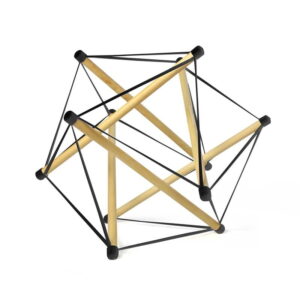 Have you ever heard of biotensegrity? The pictured structure shows tensegrity. As we discuss lower back pain I want you to think about how biotensegrity affects us. The children’s toy is an example of having all these bits of wood floating between lines of tension. Whatever you wish, you can think of these rubber bands representing muscles, connective tissue, tendons, or ligaments. The sticks that symbolize the bones are not a jumbled mess, even though each of these rubber bands pulls in. They’re not all just a pile of broken sticks. The result is what’s known as a perfect biotensegrity of a structure, created when there is an ideal band bounce between tension or strength and mobility, the alignment or mobility.
Have you ever heard of biotensegrity? The pictured structure shows tensegrity. As we discuss lower back pain I want you to think about how biotensegrity affects us. The children’s toy is an example of having all these bits of wood floating between lines of tension. Whatever you wish, you can think of these rubber bands representing muscles, connective tissue, tendons, or ligaments. The sticks that symbolize the bones are not a jumbled mess, even though each of these rubber bands pulls in. They’re not all just a pile of broken sticks. The result is what’s known as a perfect biotensegrity of a structure, created when there is an ideal band bounce between tension or strength and mobility, the alignment or mobility.
A Closed System of Tension
We are one of these structures, a closed system of tension. So keep an eye on what occurs if one muscle becomes very tight and short. It’s going to become strained, or it’s going to get tighter and tighter until it pulls those bones so close together that they start to rub. On the other hand, if this muscle is damaged or overstretched, the form begins to break down, and you get friction or degeneration elsewhere. Therefore, being overly loose or tight can both be detrimental. When we apply this to lower back pain, what happens is that there is an imbalance between the front muscles and connective tissue, or the fascia and the front muscles of the body, especially the hip flexors, which include the psoas, iliacus, portions of the adductors, and even parts of the quad.
Next is the posterior fascia, which travels up the back of the body through the erectors, up the spine, and attaches to the base of the skull. It comprises the glutes, hamstrings, and rear of the body. The tensegrity or biotensegrity of your body must be restored to fix your issue, whether it be a bulging disc or a strained back.
Isolating and Strengthening Muscles to Heal Lower Back Pain
And we do that with resistance stretching by isolating and strengthening the muscles that have gotten too weak or too loose and then using eccentric load not only to increase strength through range of motion but also to permanently fix your posture. So you don’t have to think about it. The procedure is the same whether we need to deal with a muscle that has grown too short and tight. We isolate that muscle, work on the knots and tightness there, and then under eccentric load, we release that tension, which once more improves appropriate posture and mobility.
When it comes to a bulging disc, we’re doing that to release pressure on the intervertebral disc and enable the disc bulge to heal back into the torn center. When we discuss the facet joints, we use resistance stretching to alter the pelvic posture and relieve pressure on the spine’s joints.
And if we can accomplish that, give your spine more mobility and flexibility, and educate your body on how to divide the spine from the pelvis in order to hinge from your hips when you sit, you won’t ever throw out your back again.

